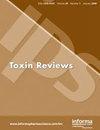黑草氯仿部分对东莨菪碱致大鼠记忆损伤的神经保护和抗遗忘作用
IF 2.4
4区 医学
Q2 TOXICOLOGY
引用次数: 0
摘要
摘要本研究旨在探讨黑草总提取物(NTE)和氯仿提取物(NCE)对东莨菪碱(SCO)致大鼠记忆损伤的神经保护和抗遗忘作用。经植物提取和分离后,在东莨菪碱给药前分别给予不同剂量的NTE(200、400、800 mg/kg)和NCE(50、100、200 mg/kg),与多奈哌齐(DON)相比,连续7 d。评估治疗动物的学习能力和记忆能力,并进一步评估大鼠脑样品的体内乙酰胆碱酯酶(AChE)活性和脂质过氧化,最后通过组织病理学检查进行验证。NTE和NCE预处理有效地提高了海马和皮质组织的抗氧化活性,降低了胆碱酯酶活性和丙二醛(MDA)含量,并减轻了东莨菪碱引起的行为和组织学变化,其效果与DON相当。病理结果显示,NCE剂量为200 mg/kg时毒性最大。观察到的NCE的神经保护和抗遗忘作用表明,该成分可能是一个有希望的候选物,无论是进一步研究分离活性成分,还是用于认知障碍患者的临床试验。关键词:阿尔茨海默病,记忆和学习障碍,抗胆碱酯酶活性,三氯甲烷igella sativachlo仿部分感谢作者感谢伊朗克尔曼医科大学给予的资助。somayyeh Karami-Mohajeri和Fariba shariffar设计并指导了实验研究,Elham Jafari, Ali Hashemian和hamideh Bashiri负责收集肿瘤组织,进行组织病理学实验。Neda Mohamadi和Mahya Shahriari撰写了手稿,分离了植物提取物,并进行了实验。本研究经伊朗克尔曼医科大学伦理委员会伦理规范ir . kmuu . rec .1399.573批准。声明作者无利益冲突需要申报。数据可用性声明数据包含在本文中。本研究由伊朗克尔曼医科大学资助(资助号:99000711,Fariba shariffar)。本文章由计算机程序翻译,如有差异,请以英文原文为准。
Evaluation of neuroprotective and anti-amnesic effects of the chloroform fraction of Nigella sativa L. on scopolamine-induced memory impairment in rats
AbstractThe aim of this study was to investigate the neuroprotective and anti-amnesic effects of total extract (NTE) and chloroform fraction of Nigella sativa (NCE) on scopolamine (SCO)-induced memory impairment in the rat. After plant extraction and fractionation, the rats were treated with different doses of NTE (200, 400, and 800 mg/kg) and NCE (50, 100 or 200 mg/kg) before scopolamine administration for 7 successive days compared to donepezil (DON). Learning power and memory capacity of the treated animals were evaluated and the rat brain samples were further assessed for in vivo acetylcholinesterase (AChE) activity, lipid peroxidation, and finally validated by histopathological examination. Pretreatment with NTE and NCE effectively increased antioxidant activity, decreased cholinesterase activity and malondialdehyde (MDA) content in the hippocampal and cortical tissues as well as mitigated scopolamine-induced behavioral, and histological changes in a manner comparable to DON. Based on the pathology results, the most toxicity of NCE was observed at 200 mg/kg. The observed neuroprotective and anti-amnesic effects of NCE indicate that this fraction could be a promising candidate both for further studies to isolate the active components and for use in clinical trials in patients with cognitive impairment.Keywords: Alzheimer’s diseasememory and learning povertyanticholinesterase activityNigella sativachloroform fraction AcknowledgementThe authors are grateful for the financial support given by Kerman university of medical sciences, Kerman, Iran.Authors contributionsSomayyeh Karami-Mohajeri and Fariba Sharififar designed and directed the experimental studies, Elham Jafari, Ali Hashemian and hamideh Bashiri were responsible for collection of tumor tissue, carrying out the histopathological experiments. Neda Mohamadi and Mahya Shahriari contributed to write the manuscript, fractionate the plant extract, and performed the experiments.Ethical statementThis study was approved by the ethics code IR.KMU.REC.1399.573 in the ethics committee of Kerman University of Medical Sciences, Iran.Disclosure statementThe author has no conflicts of interest to declare.Data availability statementThe data are included in this article.Additional informationFundingThis work was supported by Kerman University of Medical Science, Kerman, Iran, under (Grant Number: 99000711, Fariba Sharififar).
求助全文
通过发布文献求助,成功后即可免费获取论文全文。
去求助
来源期刊

Toxin Reviews
医学-毒理学
CiteScore
6.80
自引率
0.00%
发文量
36
审稿时长
>12 weeks
期刊介绍:
Toxin Reviews provides an international forum for publishing state-of-the-art reviews and guest-edited single topic special issues covering the multidisciplinary research in the area of toxins derived from animals, plants and microorganisms. Our aim is to publish reviews that are of broad interest and importance to the toxinology as well as other life science communities. Toxin Reviews aims to encourage scientists to highlight the contribution of toxins as research tools in deciphering molecular and cellular mechanisms, and as prototypes of therapeutic agents. Reviews should emphasize the role of toxins in enhancing our fundamental understanding of life sciences, protein chemistry, structural biology, pharmacology, clinical toxinology and evolution. Prominence will be given to reviews that propose new ideas or approaches and further the knowledge of toxinology.
 求助内容:
求助内容: 应助结果提醒方式:
应助结果提醒方式:


